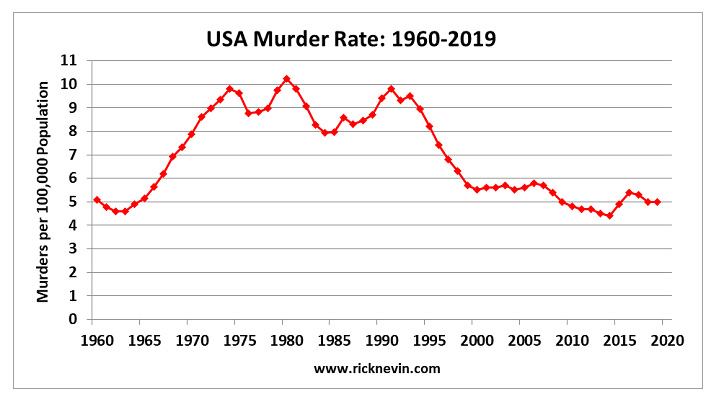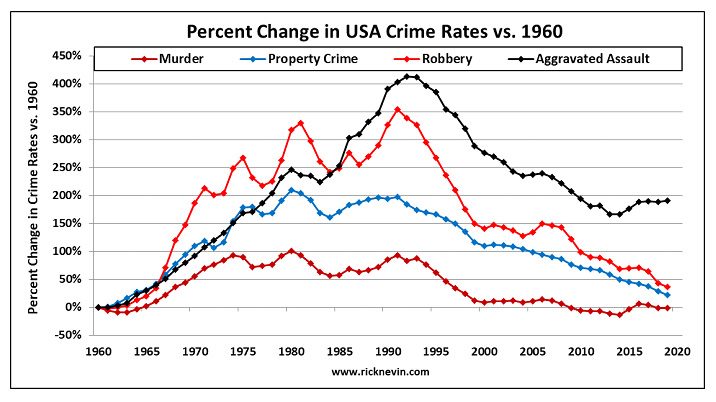Context for recent “crime surge” commentary
In 2013, the USA murder rate fell to the lowest level ever recorded in FBI data that goes back to 1960. The FBI and the news media did not think that milestone was worth noting. In 2014, the murder rate fell to another new record low, again without any media attention. In 2015, there was a widely reported spike in the murder rate, and murders increased again in 2016, but fell in 2017 and 2018. The murder rate in 2018 and 2019 was 5.0 per 100,000 population, just slightly lower than the 5.1 rate recorded in 1960.

The murder rate almost doubled from 1960 to 1974, was slightly higher in 1980, and close to that record high again in 1991. That 100% increase in the murder rate was far exceeded by the surge in other felony crimes. From 1960-1991, the property crime rate (burglary, auto theft, and other felony theft) increased 200%, the robbery rate rose 350%, and the aggravated assault rate rose 400%.
From 1991-2019, robbery and property crime rates recorded massive declines, tracking earlier declines in preschool lead exposure. In 2019, robbery and property crime rates were at the lowest levels recorded since the mid-1960s. The aggravated assault rate also recorded a massive decline from 1991-2011 but has leveled off since 2011.

There is good reason to expect that the aggravated assault rate will eventually follow the ongoing declines in robbery and property crime rates. Juveniles account for a much larger share of robbery and property crime arrests than aggravated assault arrests and juveniles have recorded the largest decline in arrest rates due to birth year trends in lead exposure. There is also evidence that the percent of domestic violence assaults recorded by police has increased since the 1980s. An increase in the percent of crimes recorded would slow the decline in recorded aggravated assaults. A comparison of National Crime Victimization Survey (NCVS) and FBI police recorded crime trends shows a steeper decline in the NCVS reported aggravated assault rate.
In 2020, there have been widespread media reports about spiking murder rates and surging crime. FBI data for the first six months of 2020 confirm a spike in murders but show no evidence of an overall crime surge. Compared to the first six months of 2019, the number of murders rose 14.8%, robberies fell 7.1%, aggravated assaults rose 4.6%, and property crime fell 7.8%. If those percent changes hold for the full year then the murder rate will rise to 5.7 per 100,000, the robbery rate will fall to the lowest level since 1965, the aggravated assault rate will rise slightly, and the property crime rate will fall to its lowest level since 1963.
Media reports about the 2020 spike in murders often link that news with commentary about riots in 2020, implying that civil disorder caused the homicide spike. A more likely explanation comes from available data from Memphis, Milwaukee, Jefferson Parish LA, Tarrant County TX, and the Seattle area showing especially large spikes in domestic violence homicides, likely due to the emotional, psychological, and financial stress created by the COVID-19 pandemic.
